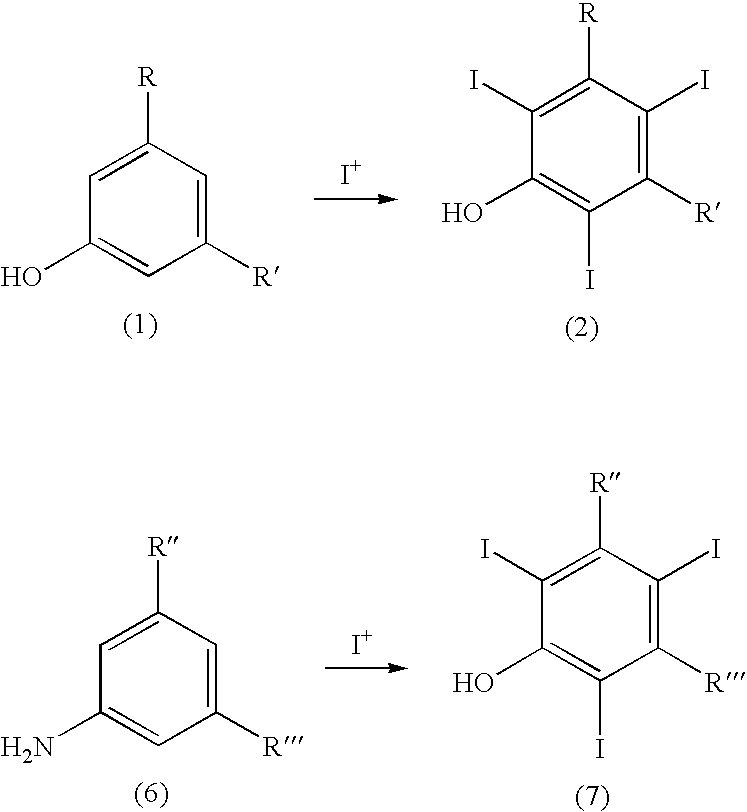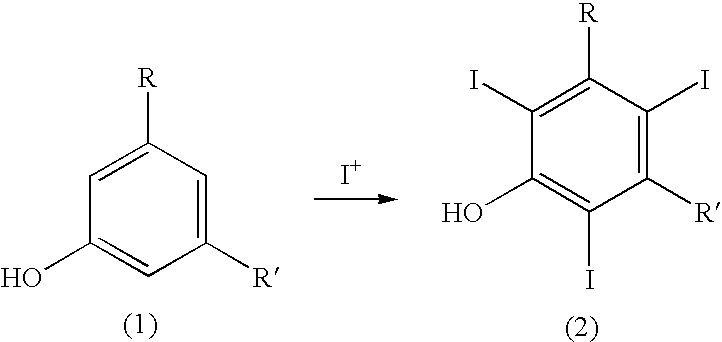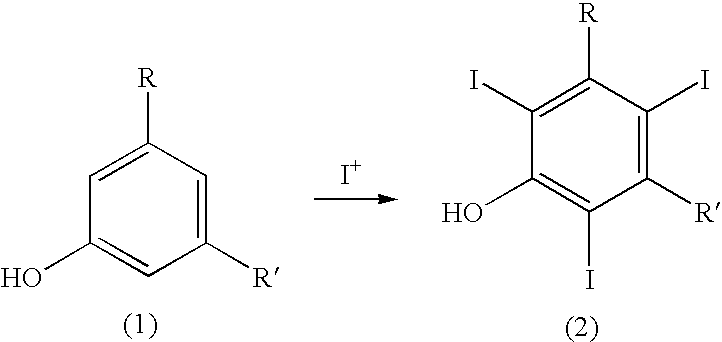Process for the iodination of aromatic compounds
- Summary
- Abstract
- Description
- Claims
- Application Information
AI Technical Summary
Benefits of technology
Problems solved by technology
Method used
Image
Examples
example 2
Synthesis of 3,5-bis(2,3-dihydroxypropylaminocarbonyl)-2,4,6-triiodophenol
[0091]
[0092]3,5-Bis(2,3-dihydroxypropylaminocarbonyl)-phenol (56.5 mg, 0.17 mmol) was added in a round bottomed flask containing the I+ solution (obtained by working as described in Example 1, from 1.55 mmol I2 and 50 mL MeOH). The reaction mixture was refluxed for 1 hour. An additional amount of 3,5-bis(2,3-dihydroxypropylaminocarbonyl)-phenol (56.5 mg, 0.17 mmol) was then added and the solution was refluxed for 1 hour. A third portion of 3,5-bis(2,3-dihydroxypropylaminocarbonyl)-phenol was finally added (56.5 mg, 0.17 mmol) and the solution was refluxed until complete conversion was observed. After cooling, KI (257 mg, 1.55 mmol) was added and a saturated aqueous solution of Na2SO3 was added dropwise until the solution became pale yellow.
[0093]Methanol was removed under reduced pressure and the yellow residue was purified with an Amberlite® XAD 1600 column by elution with water (100 mL) until salts were comp...
example 3
Synthesis of 3,5-bis(1-hydroxymethyl-2-hydroxyethylaminocarbonyl)-2,4,6-triiodophenol
[0097]
[0098]3,5-Bis(1-hydroxymethyl-2-hydroxyethylaminocarbonyl)-phenol (56.5 mg, 0.17 mmol) was added in a round bottomed flask containing the I+ solution (obtained by working as described in Example 1, from 1.55 mmol I2 and 50 mL MeOH).
[0099]The reaction mixture was refluxed for 1 hour. An additional amount of the above phenol derivative (56.5 mg, 0.17 mmol) was then added and the solution was refluxed for 1 hour. A third portion of the above phenol derivative was finally added (56.5 mg, 0.17 mmol) and the solution was refluxed until complete conversion was observed. After cooling, KI (257 mg, 1.55 mmol) was added and a saturated aqueous solution of Na2SO3 was added dropwise until the solution became pale yellow.
[0100]Methanol was removed under reduced pressure and the yellow residue was purified with an Amberlite® XAD 1600 column by elution with water (100 mL) until salts were completely removed ...
example 4
Synthesis of 3,5-bis(n-butoxycarbonyl)-2,4,6-triiodophenol
[0104]
[0105]In a round bottomed flask containing the I+ solution (obtained by working as described in Example 1, from 0.78 mmol I2 and 50 mL MeOH), 3,5-bis(n-butoxycarbonyl)-phenol (25.0 mg, 0.085 mmol) was added. The solution obtained was refluxed for 1 hour. An additional amount of the above phenol derivative was then added (25.0 mg, 0.085 mmol) and the solution was refluxed for 1 hour. A third portion of the above phenol derivative was finally added (25.0 mg, 0.085 mmol) and the solution was refluxed 7 h, until complete conversion was observed.
[0106]After cooling, KI (125 mg, 0.76 mmol) was added and a saturated aqueous solution of Na2SO3 was dropped until the solution became pale yellow.
[0107]Methanol was removed under reduced pressure and the yellow solution so obtained was diluted with water and extracted with AcOEt (3×20 mL). The organic phase was dried over Na2SO4 and evaporated under reduced pressure. The black resid...
PUM
| Property | Measurement | Unit |
|---|---|---|
| Electric potential / voltage | aaaaa | aaaaa |
| Electric potential / voltage | aaaaa | aaaaa |
| Current density | aaaaa | aaaaa |
Abstract
Description
Claims
Application Information
 Login to View More
Login to View More - R&D
- Intellectual Property
- Life Sciences
- Materials
- Tech Scout
- Unparalleled Data Quality
- Higher Quality Content
- 60% Fewer Hallucinations
Browse by: Latest US Patents, China's latest patents, Technical Efficacy Thesaurus, Application Domain, Technology Topic, Popular Technical Reports.
© 2025 PatSnap. All rights reserved.Legal|Privacy policy|Modern Slavery Act Transparency Statement|Sitemap|About US| Contact US: help@patsnap.com



